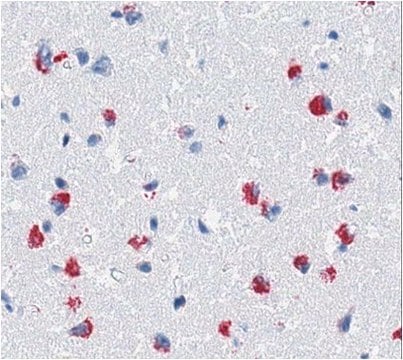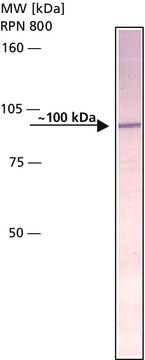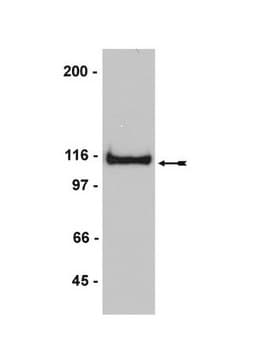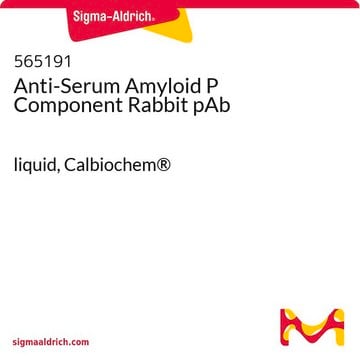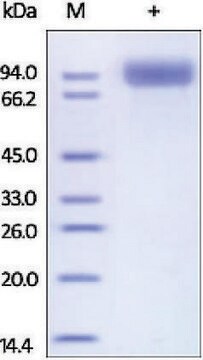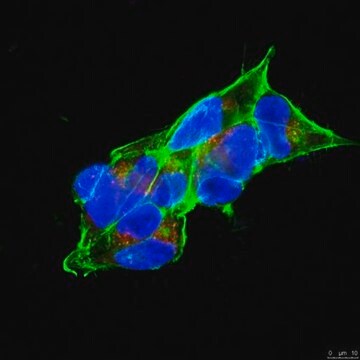171610
Anti-Amyloid Precursor Protein, C-Terminal (751-770) Rabbit pAb
liquid, Calbiochem®
Synonym(s):
Anti-0443, Anti-APP-CT20
Sign Into View Organizational & Contract Pricing
All Photos(1)
About This Item
UNSPSC Code:
12352203
NACRES:
NA.43
Recommended Products
biological source
rabbit
Quality Level
antibody form
serum
antibody product type
primary antibodies
clone
polyclonal
form
liquid
species reactivity
human
manufacturer/tradename
Calbiochem®
storage condition
OK to freeze
isotype
IgG
shipped in
ambient
storage temp.
−20°C
target post-translational modification
unmodified
General description
Anti-Amyloid Precursor Protein, C-Terminal (751-770), rabbit polyclonal, recognizes full-length APP and C-terminal soluble products CTFα, β, and γ. It is validated for WB, IF, IHC, and IP.
Rabbit polyclonal antibody supplied as undiluted serum. Recognizes full-length APP and C-terminal soluble products CTFγ (~6 kDa), CTFα (~9 kDa), and CTFβ (~11 kDa).
Recognizes full-length APP and C-terminal soluble products CTFγ (~6 kDa), CTFα (~9 kDa), and CTFβ (~11 kDa).Antibody Target Gene Symbol: APP Target Synonym: AAA, AD1, Adap, AL024401, Amyloid precursor, Amyloidogenic glycoprotein, APP isoform 1, APPI, appican, CTFgamma, CVAP, E030013M08RIK, Nexin II, P3, PN2, PreA4, PROTEASE NEXIN2 Entrez Gene Name: amyloid beta (A4) precursor protein Hu Entrez ID: 351 (Related Antibodies: PC729, PC152,PC151, PC150, PC149, NE1012,171609, 171608, 171607, 171606, 171605, 171604, 171603, 171598, 171537) Mu Entrez ID: 11820 Rat Entrez ID: 54226
Immunogen
Human
a synthetic peptide [(C)KMQQNGYENPTYKFFEQMQN] corresponding to amino acids 751-770 of human precursor protein (APP), conjugated to KLH
Application
Immunoblotting (1:5000-1:20,000)
Immunofluorescence (1:1000)
Immunohistochemistry (1:1000)
Immunoprecipitation (1:1000)
Immunofluorescence (1:1000)
Immunohistochemistry (1:1000)
Immunoprecipitation (1:1000)
Warning
Toxicity: Standard Handling (A)
Reconstitution
Following initial thaw, aliquot and freeze (-20°C).
Other Notes
Pinnix, I., et al. 2001. J. Biol. Chem.276, 481.
Variables associated with assay conditions will dictate the proper working dilution.
Legal Information
Purchase of this material is for research use only. Users are invited to request a license from Mayo prior to using the 0433 antibody or any derivatives for clinical diagnostic or therapeutic purposes. For license information, please contact: Mayo Medical Ventures, Office of Technology Commercialization (507) 284-8878, 200 First Street SW, Rochester, MN 55905-001.
CALBIOCHEM is a registered trademark of Merck KGaA, Darmstadt, Germany
Not finding the right product?
Try our Product Selector Tool.
Storage Class Code
10 - Combustible liquids
WGK
WGK 1
Flash Point(F)
Not applicable
Flash Point(C)
Not applicable
Certificates of Analysis (COA)
Search for Certificates of Analysis (COA) by entering the products Lot/Batch Number. Lot and Batch Numbers can be found on a product’s label following the words ‘Lot’ or ‘Batch’.
Already Own This Product?
Find documentation for the products that you have recently purchased in the Document Library.
Ramon Velazquez et al.
Aging cell, 18(6), e13037-e13037 (2019-09-29)
Currently, there are no effective therapies to ameliorate the pathological progression of Alzheimer's disease (AD). Evidence suggests that environmental factors may contribute to AD. Notably, dietary nutrients are suggested to play a key role in mediating mechanisms associated with brain
Inderjeet Saluja et al.
Neurobiology of disease, 36(1), 162-168 (2009-07-28)
The neuronal adaptor protein X11alpha/mint-1/APBA-1 binds to the cytoplasmic domain of the amyloid precursor protein (APP) to modulate its trafficking and metabolism. We investigated the consequences of reducing X11alpha in a mouse model of Alzheimer's disease (AD). We crossed hAPPswe/PS-1DeltaE9
Ramon Velazquez et al.
Molecular psychiatry, 25(10), 2620-2629 (2019-01-10)
The lack of effective treatments for Alzheimer's disease (AD) is alarming, considering the number of people currently affected by this disorder and the projected increase over the next few decades. Elevated homocysteine (Hcy) levels double the risk of developing AD.
Xiqian Lan et al.
Journal of neuroimmune pharmacology : the official journal of the Society on NeuroImmune Pharmacology, 7(2), 412-423 (2011-08-10)
Combined antiretroviral therapy (ART) tremendously improved the lifespan and symptoms associated with AIDS-defining illness in affected individuals. However, chronic ART-treated patients frequently develop age-dependent complications, including dementia, diabetes, and hyperlipidemia: all risk factors of Alzheimer's disease. Importantly, the effect of
Giselle P Lim et al.
The Journal of neuroscience : the official journal of the Society for Neuroscience, 25(12), 3032-3040 (2005-03-25)
Epidemiological studies suggest that increased intake of the omega-3 (n-3) polyunsaturated fatty acid (PUFA) docosahexaenoic acid (DHA) is associated with reduced risk of Alzheimer's disease (AD). DHA levels are lower in serum and brains of AD patients, which could result
Our team of scientists has experience in all areas of research including Life Science, Material Science, Chemical Synthesis, Chromatography, Analytical and many others.
Contact Technical Service


